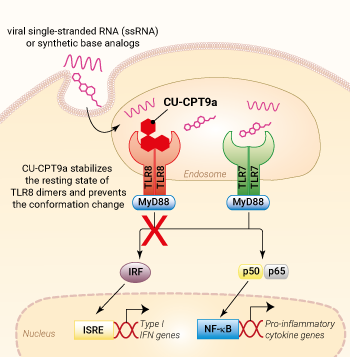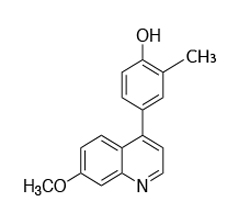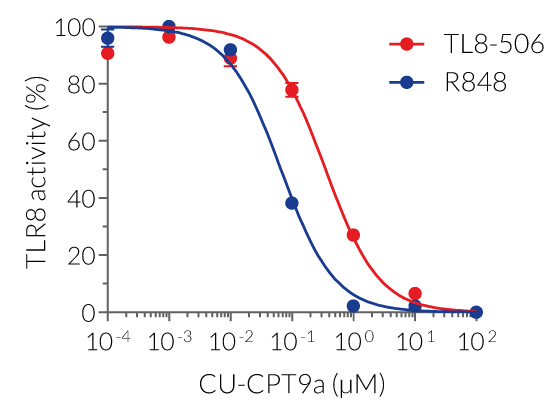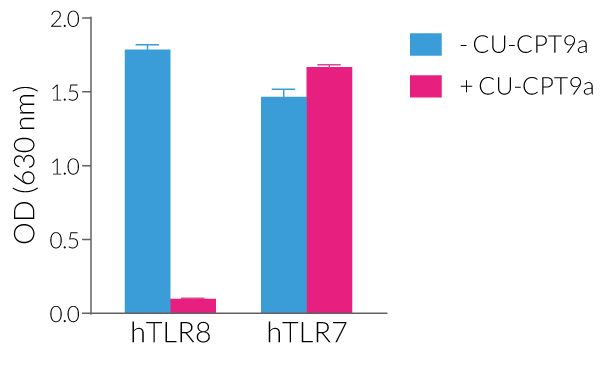CU-CPT9a
| Product | Unit size | Cat. code | Docs. | Qty. | Price | |
|---|---|---|---|---|---|---|
|
CU-CPT9a TLR8 Antagonist - InvitroFit™ |
Show product |
10 mg |
inh-cc9a
|
|
Specific TLR8 inhibitor

Inhibition of TLR8 signaling by CU-CPT9a
CU-CPT9a is a potent and selective inhibitor of Toll-like receptor 8 (TLR8) [1-4]. CU-CPT9a has been used to establish previously unknown functions of TLR8 as a dominant sensor of pyrogenic Gram‑positive bacteria (i.e. S. aureus) as well as having an important role in sensing Gram‑negative bacteria (i.e. E. coli and P. aeruginosa) [4]. Additionally, CU-CPT9a has been shown to exert potent anti-inflammatory effects in samples from patients with inflammatory diseases such as osteoarthritis (OA), rheumatoid arthritis (RA), and adult-onset Still’s disease (AOSD) [1].
Mode of action
Under normal conditions, the binding of a TLR8 agonist, such as R848 or ssRNA, induces two TLR8 protomers to be brought into proximity and initiates downstream NF-κB-dependent signaling [1]. CU‑CPT9a binds to and stabilizes the TLR8 dimer in its resting state. Subsequently, the stabilization of the resting state prevents TLR8 from undergoing the necessary conformational change for activation [1]. Therefore, CU‑CPT9a prevents TLR8 activation and antagonizes any binding of TLR8 ligands. Importantly, CU-CPT9a blocks the activation of TLR8 and the subsequent NF-κB signaling without having any effect on other TLRs, especially the closely related TLR7 [1-3].
Key features of CU-CPT9a
- CU-CPT9a specifically inhibits TLR8.
- CU-CPT9a binds directly to TLR8 and blocks the conformational change needed for activation.
- InvitroFit™: each lot of CU-CPT9a is highly pure (≥95%) and functionally tested.
References:
1. Zhang S. et al., 2018. Small-molecule inhibition of TLR8 through stabilization of its resting state. Nat Chem Biol, 14(1):58-64.
2. Hu Z. et al., 2022. Protocol for evaluation and validation of TLR8 antagonists in HEK-Blue cells via secreted embryonic alkaline phosphatase assay. STAR Protoc. 3(1):101061.
3. Hu Z. et al., 2018. Small-molecule TLR8 antagonists via structure-based rational design. Cell Chem Biol. 25(10):1286-91.
4. Moen S.H. et al., 2019. Human Toll-like Receptor 8 (TLR8) is an Important Sensor of Pyogenic Bacteria and Is Attenuated by Cell Surface TLR Signaling. Front Immunol, 10:1209.
Specifications
CAS number: 2165340-32-7
Formula: C17H15NO2
Molecular weight: 265.31 g/mol
Solubility: 100 mM DMSO
Working concentration: 1 - 10 μM for cell culture assays
Quality control:
- Purity: ≥95% (UHPLC)
- Specific inhibition of human TLR8 by CU-CPT9a has been confirmed using cellular assays.
- The absence of bacterial contamination (e.g. lipoproteins and endotoxins) has been confirmed using HEK-Blue™ hTLR2 and HEK-Blue™ hTLR4 cells.
Contents
- 10 mg CU-CPT9a provided as a dried powder
- 5 ml CU-CPT9a Diluent provided as a clear solution
![]() CU-CPT9a is shipped at room temperature.
CU-CPT9a is shipped at room temperature.
![]() Upon receipt, store CU-CPT9a at -20 °C and CU-CPT9a Diluent at 4 °C. Upon resuspension of CU-CPT9a in DMSO, prepare aliquots and store at -20 °C.
Upon receipt, store CU-CPT9a at -20 °C and CU-CPT9a Diluent at 4 °C. Upon resuspension of CU-CPT9a in DMSO, prepare aliquots and store at -20 °C.
![]() Resuspended product is stable for at least 3 months when properly stored.
Resuspended product is stable for at least 3 months when properly stored.
![]() Avoid repeated freeze-thaw cycles.
Avoid repeated freeze-thaw cycles.
Details
TLR7 and TLR8
TLR7 and TLR8 are endosomal pattern recognition receptors that share structural homology [1]. Both receptors are activated by single-stranded RNA (ssRNA) molecules, however, they exhibit different ligand-binding specificities and cellular expression patterns suggesting that they have nonredundant specialized roles.
TLR7 is essentially expressed by plasmacytoid dendritic cells (pDCs) but is also found in B cells and other myeloid cells [2] while TLR8 is highly expressed by myeloid cells and is absent from pDCs and B cells [2].
The endosomal distribution of TLR7 and TLR8 allows them to scan for the presence of microbial RNA in the phagocytic cargo. Their activation leads to NF-κB-, AP1-, and interferon regulatory factor (IRF)-mediated production of type I interferons (IFN-α/β) and pro-inflammatory cytokines [2].
Structural analyses have revealed that both TLR7 and TLR8 possess two binding sites (designated as Site 1 and Site 2) which do not share the same specificities.
Site 1 is highly conserved between TLR7 and TLR8 and binds nucleosides (guanosine (G) for TLR7 and uridine (U) for TLR8) or base analogs. The ligand preference for TLR7 and TLR8 is thus explained by the presence of specific residues in Site 1. Site 1 occupancy allows receptor dimerization and signaling.
Site 2 is less conserved and binds ssRNA with U(U) and U(G) motifs, respectively [3, 4]. Of note, ssRNA-binding to Site 2 is not sufficient for the formation of a signaling-competent TLR dimer but it strongly enhances the binding affinity of Site 1 [3, 4]. Thus, TLR7 and TLR8 appear to sense distinct RNA-degradation products rather than full-length ssRNAs [4].
1. Chuang T.H. & Ulevitch R.J., 2000. Cloning and characterization of a sub-family of human toll-like receptors: hTLR7, hTLR8, and hTLR9. Eur Cytokine Netw, 11:372-8.
2. Georg P. & Sander L.E., 2019. Innate sensors that regulate vaccine responses. Curr. Op. Immunol. 59:31.
3. Zhang Z. et al., 2018. Structural analyses of Toll-like receptor 7 reveal detailed RNA sequence specificity and recognition mechanism of agonistic ligands. Cell Rep. 25:3371.
4. Tanji H. et al., 2015. Toll-like receptor 8 senses degradation products of single-stranded RNA. Nat. Struct. Mol. Biol. 22:109.
Chemical structure of CU-CPT9a









